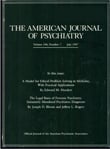TO THE EDITOR: Tollefson and colleagues presented the results of a multicenter, double-blind, collaborative trial that reported a superior and broader spectrum of efficacy in the treatment of schizophrenia, with a substantially more favorable safety profile, for olanzapine than for haloperidol. It is worth noting, however, that there are at least four aspects in this trial that need further attention.
It was surprising that despite the international and collaborative nature of the study, the 174 sites that took part were not cited in the article. They were from Europe and North America and recruited both in- and outpatients, but further details were not given. Information on the characteristics of these centers would have been of value in interpreting the data presented, since there was great variability in the number of patients who entered the trial at each center (from one patient in 13 sites to 73 patients at one center). Differences among the centers (e.g., urban versus rural, in- versus outpatient services) might have been a valid reason for such variability, but different enrollment criteria might also have been responsible. This possibility is further supported by the fact that a quite heterogeneous population was recruited. While the majority of the patients had schizophrenia of the paranoid subtype, no information is provided on the number of schizophrenic patients included or their distribution between the two treatment arms, nor is there information on the distribution of chronic patients. In addition, it would have been of interest to know the proportion who were enrolled during an exacerbation of their illness. Around 77% of the group were intolerant of current antipsychotic therapy (excluding haloperidol), but no details on how this intolerance was measured are provided. Finally, patients were required to have a minimum Brief Psychiatric Rating Scale (BPRS) score of 18, but no reason is provided to justify this choice. Overall, it is not clear to which patients the results of the present trial apply.
The study compared olanzapine, 5–20 mg/day, to haloperidol, 5–20 mg/day. The baseline severity of illness scores showed that the haloperidol-treated patients had significantly higher mean total scores on the BPRS and the Positive and Negative Syndrome Scale. In other words, the comparison group had more severe symptoms than the experimental group at baseline. In addition, the haloperidol group received lower drug doses than the olanzapine group during the acute phase of the study. Hence, one cannot rule out the possibility that this unbalanced situation may have hampered the results of the trial, in terms of both efficacy and safety.
The study supported the notion that olanzapine had significant advantages over haloperidol in terms of negative symptoms and extrapyramidal side effects. However, it would have been useful to consider the temporal relationship between negative symptoms and extrapyramidal side effects in order to rule out the possibility of an association. In fact, an improvement in negative symptoms may be due to resolution of “secondary,” i.e., extrapyramidal, symptoms, as has been proposed for clozapine (
1). If this association holds, any advantage of a new neuroleptic in terms of extrapyramidal and negative symptoms should not be tested against haloperidol, since this drug produces more extrapyramidal side effects than other typical neuroleptics and therefore cannot be considered the “gold standard.”
Finally, it would have been helpful to have details on the blind nature of the trial. No information is provided on efforts to ensure blind data analysis, or “triple masking” (
2), a procedure that is now becoming common.

